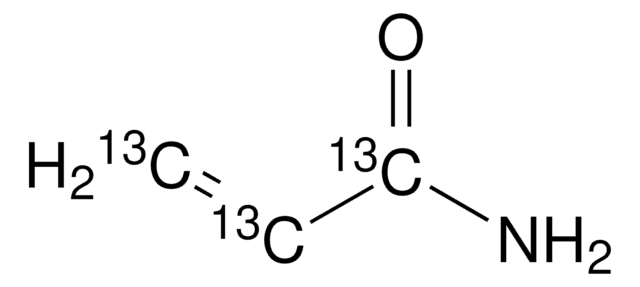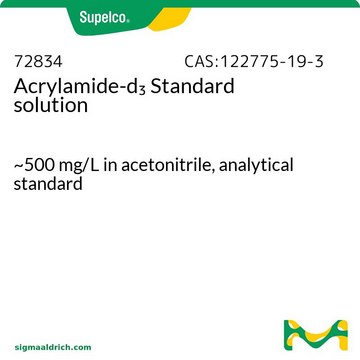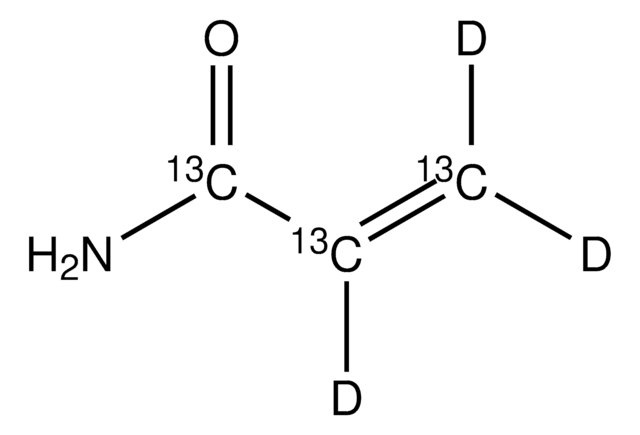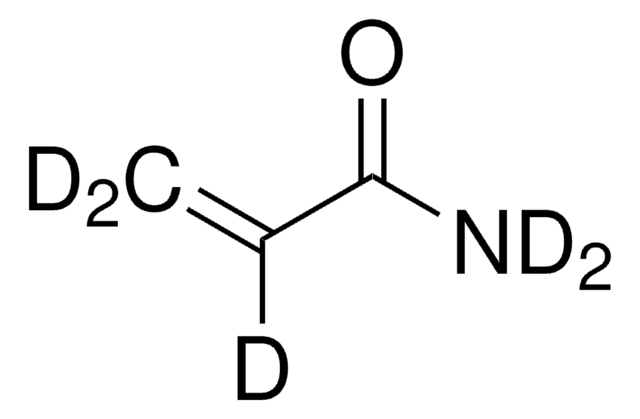23701
Acrylamide
analytical standard
Synonyme(s) :
2-Propenamide, Acrylic acid amide
About This Item
Produits recommandés
Qualité
analytical standard
Niveau de qualité
Densité de vapeur
2.45 (vs air)
Pression de vapeur
0.03 mmHg ( 40 °C)
Pureté
≥99.0% (GC)
Durée de conservation
limited shelf life, expiry date on the label
Technique(s)
HPLC: suitable
gas chromatography (GC): suitable
Point d'ébullition
125 °C/25 mmHg (lit.)
Pf
82-86 °C (lit.)
Solubilité
water: soluble 200 g/L at 20 °C
Application(s)
cleaning products
cosmetics
environmental
food and beverages
personal care
Format
neat
Chaîne SMILES
NC(=O)C=C
InChI
1S/C3H5NO/c1-2-3(4)5/h2H,1H2,(H2,4,5)
Clé InChI
HRPVXLWXLXDGHG-UHFFFAOYSA-N
Vous recherchez des produits similaires ? Visite Guide de comparaison des produits
Description générale
Application
- Environmental water samples using ion-exclusion chromatography-mass spectrometry system (IEC-MS).
- Cereal-based food products by gas chromatography coupled to mass spectrometry (GC–MS) and reversed phase-high performance liquid chromatography with diode array detection (RP-HPLC-DAD).
- Potato-based foods by liquid chromatography with diode array detection (LC–DAD).
Refer to the products certificate of analysis for more information on a suitable instrument technique. Contact Technical Service for further support.
Produit(s) apparenté(s)
Mention d'avertissement
Danger
Mentions de danger
Classification des risques
Acute Tox. 3 Oral - Acute Tox. 4 Dermal - Acute Tox. 4 Inhalation - Carc. 1B - Eye Irrit. 2 - Muta. 1B - Repr. 2 - Skin Irrit. 2 - Skin Sens. 1 - STOT RE 1 Oral
Organes cibles
Peripheral nervous system
Code de la classe de stockage
6.1C - Combustible acute toxic Cat.3 / toxic compounds or compounds which causing chronic effects
Classe de danger pour l'eau (WGK)
WGK 3
Point d'éclair (°F)
280.4 °F - closed cup
Point d'éclair (°C)
138 °C - closed cup
Équipement de protection individuelle
Eyeshields, Faceshields, Gloves, type P3 (EN 143) respirator cartridges
Faites votre choix parmi les versions les plus récentes :
Déjà en possession de ce produit ?
Retrouvez la documentation relative aux produits que vous avez récemment achetés dans la Bibliothèque de documents.
Les clients ont également consulté
Notre équipe de scientifiques dispose d'une expérience dans tous les secteurs de la recherche, notamment en sciences de la vie, science des matériaux, synthèse chimique, chromatographie, analyse et dans de nombreux autres domaines..
Contacter notre Service technique









